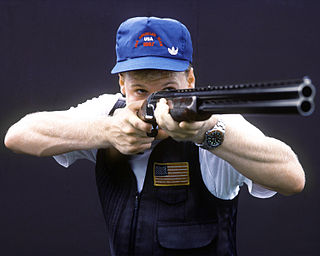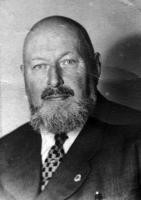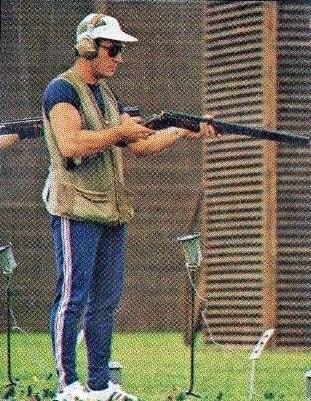
Shooting sports have been included at every Summer Olympic Games since the birth of the modern Olympic movement at the 1896 Summer Olympics except at the 1904 and 1928 games.

The ISSF World Shooting Championships are governed by the International Shooting Sport Federation. World Shooting Championships began in 1897, after the successful 1896 Summer Olympics, and although the ISSF was not founded until 1907, these early competitions are still seen by the organization as the beginning of a continuous row of championships. By this logic, the 2006 competition in Zagreb was called the 49th ISSF World Shooting Championships. These championships, including all ISSF shooting events, are held every four years since 1954. For the shotgun events only, there is an additional World Championship competition in odd-numbered years. These extra competitions are not numbered. In running target, there will be World Championships in Olympic years.

Olympic skeet is a variant of skeet shooting, and the specific variant used in the Olympic Games. The discipline is sanctioned by the International Shooting Sport Federation. Two throwing machines at different heights launch a series of 25 targets in a specific order, some as singles and some as doubles, with the shooter having a fixed position between them. Both men's and women's competitions consist of five such series. The top six competitors shoot an additional series as a final round, on targets filled with special powder to show hits more clearly to the audience. The competitors use shotguns of 12 bore or smaller. All actions are allowed, including double barrel breech loaders, semi-automatic or others, but not pump action guns.

Olympic Trap is a shooting sports discipline contested at the Olympic Games and sanctioned by the International Shooting Sport Federation. Usually referred to simply as "trap", the discipline is also known in the United States as international trap, bunker trap, trench or international clay pigeon. It is considered more difficult than most other trap versions in that the distance to the targets and the speed with which they are thrown are both greater.

The men's trap was a shooting sports event held as part of the Shooting at the 1924 Summer Olympics programme. It was the fifth appearance of the event. The competition was held from 8 to 10 July 1924 at the shooting ranges at Issy-les-Moulineaux. 44 shooters from 14 nations competed. A maximum of four competitors per nation were allowed. The event was won by Gyula Halasy of Hungary, a victory in the nation's debut in the event. Silver went to Konrad Huber of Finland, that nation's first medal in the men's trap. The United States, which had earned gold in 1912 and 1920, took bronze this year with Frank Hughes on the podium.

The men's trap was a shooting sports event held as part of the Shooting at the 1920 Summer Olympics programme. It was the fourth appearance of the event. The competition was held on 23 and 24 July 1920 and 18 shooters from seven nations competed. The United States swept the podium ; it was the second sweep in the men's trap. Mark Arie took the gold medal, the second consecutive victory by an American. Frank Troeh earned silver, while Frank Wright finished with bronze. Arie also received Lord Westbury's Cup, a challenge prize previously awarded in 1908 and 1912 to the winners of those years' men's trap competitions.

The men's trap shooting competition at the 2000 Summer Olympics was held on 16 and 17 September at the Sydney International Shooting Centre. There were 41 competitors from 29 nations, with each nation having up to three shooters. By defending his title from Atlanta, Michael Diamond won the host country's only gold medal in the shooting competitions. Diamond was the second man to successfully defend an Olympic title in the trap. Ian Peel earned Great Britain's first men's trap medal since 1968. Italy's Giovanni Pellielo earned bronze.

Men's trap shooting was one of the fifteen shooting events at the 1996 Summer Olympics. It was held on 20 and 21 July 1996 at the Wolf Creek Shooting Complex. There were 58 competitors from 41 nations, with each nation having up to three shooters. Michael Diamond of Australia won, setting two new Olympic records, ahead of two Americans. After the regular 150 targets, it took a marathon shoot-off to separate the silver and bronze medalists; after both shooters had hit 27 straight targets, Josh Lakatos hit his 28th while Lance Bade missed. It was the first medal in the men's trap for Australia; the United States had most recently been on the podium in the event in 1984.

Trap was one of the thirteen shooting events at the 1992 Summer Olympics. It was the last Olympic trap competition open to both men and women. It was held from 31 July to 2 August 1992 at the Mollet del Vallès. There were 54 competitors from 36 nations, with each nation having up to 3 shooters. The competition consisted of a qualification round of 150 targets, a semifinal of 50 targets for the top 24 competitors, and a final of 25 targets for the top six. Petr Hrdlička and Kazumi Watanabe both hit 219 of the 225 targets, with Hrdlička winning the gold medal shoot-off. One hit behind, another shoot-off determined the bronze medalist, with Marco Venturini defeating Jörg Damme. Hrdlička's victory was the first gold medal for Czechoslovakia in the trap, shortly after the nation won its first medal in the event. Watanabe's silver was Japan's first medal in the trap. Venturini put Italy back on the podium after a one-Games absence in 1988 broke a four-Games medal streak in the event.

Trap was one of the thirteen shooting events at the 1988 Summer Olympics. It was held on 20 September 1988 at the Taereung International Shooting Range. There were 49 competitors from 28 nations, with each nation having up to four shooters. The event was decided by a shoot-off between Dmitry Monakov of the Soviet Union and Miloslav Bednařík of Czechoslovakia, with Monakov emerging as the winner with 8–7. Frans Peeters of Belgium took bronze after a three-way shoot-off. Monakov's victory was the first gold medal for the Soviet Union in the trap; Czechoslovakia and Belgium each received their first medal in the event as well. Italy's four-Games medal streak ended.

The trap competition at the 1976 Summer Olympics was held on 18–20 July in Montreal, Canada. There were 44 competitors from 29 nations, with each nation limited to two shooters. The event was won by Donald Haldeman of the United States, the nation's first victory in the trap since back-to-back wins in 1912 and 1920. The three total victories tied the United States with Italy for most among nations at the time, though Italy would win the next two and the United States has not win again since. In this Games, Ubaldesco Baldi of Italy took bronze. Silver went to Armando Marques of Portugal, that nation's first medal in the trap.

The trap competition at the 1972 Summer Olympics was an open-gender event held from 27 to 29 August 1972 at Schießanlage. There were 57 competitors from 34 nations, with each nation limited to two shooters. The 1970 and 1971 world champion and co-holder of the world record Michel Carrega of France finished a surprise second to Angelo Scalzone of Italy, who broke the world record with a near perfect performance of 199 out of 200. Bronze went to Silvano Basagni, also of Italy. Scalzone's victory was Italy's third gold medal in the last five Games; Carrega's medal was France's first medal in the trap since the nation swept the medals in 1900.

The men's trap event at the 2012 Olympic Games took place on 5 and 6 August 2012 at the Royal Artillery Barracks. There were 34 competitors from 27 nations. The event was won by Giovanni Cernogoraz of Croatia, the nation's first medal in the men's trap. Massimo Fabbrizi of Italy took silver, the third consecutive silver and fourth Games on the podium for Italy. Kuwait, like Croatia, earned its first medal in the men's trap; Fehaid Al-Deehani took bronze.

The trap was a shooting sports event held as part of the Shooting at the 1968 Summer Olympics programme. The competition was held on 18 and 19 October 1968 at the shooting ranges in Mexico City. 55 shooters from 34 nations competed. For the first time, the event was open to women as well as men. Nations were limited to two shooters each. The event was won by Bob Braithwaite of Great Britain, the nation's first victory in the event and first medal of any color in the trap since 1908. Silver went to Thomas Garrigus of the United States. Kurt Czekalla of East Germany took bronze; it was the first medal in the event for East Germany as a separate nation, and the first medal for any German trap shooter since 1912.

The men's trap was a shooting sports event held as part of the Shooting at the 1960 Summer Olympics programme. The competition was held from 15 to 17 October 1964 at the Tokorozawa Clay Pigeon Shooting Range in Tokorozawa, Saitama. 51 shooters from 28 nations competed. Each nation could send up to two shooters. The event was won by Ennio Mattarelli of Italy, the nation's second victory in three Games in the event. Pāvels Seničevs of the Soviet Union took silver. William Morris earned the United States' first medal in the trap since 1924 with his bronze. Seničevs and Morris defeated Galliano Rossini of Italy in a three-way shoot-off for second; Rossini thus just missed earning a third medal in the trap. Defending champion Ion Dumitrescu of Romania finished fifth.

The men's trap was a shooting sports event held as part of the Shooting at the 1952 Summer Olympics programme. It was the sixth appearance of the event. The competition was held on 25 and 26 July 1952 at the shooting ranges in Helsinki. 40 shooters from 22 nations competed. Each nation could have up to 2 shooters. The event was won by George Genereux of Canada, the nation's first victory in the event since 1908. Sweden, which had never before medaled in the men's trap, took two medals this Games, with Knut Holmqvist earning silver and Hans Liljedahl bronze.

The men's trap was a shooting sports event held as part of the Shooting at the 1956 Summer Olympics programme. It was the seventh appearance of the event. The competition was held from 29 November to 1 December 1956 at the shooting ranges in Melbourne. 32 shooters from 18 nations competed. Nations were limited to two shooters each. The event was won by Galliano Rossini of Italy, with his countryman Alessandro Ciceri taking bronze. Between the two Italians was Adam Smelczyński of Poland, earning bronze. They were the first medals in the men's trap for both nations. Ciceri had to win a three-way shoot-off for the bronze medal against the Soviet pair, Nikolay Mogilevsky and Yury Nikandrov; his win in that shoot-off made the men's trap the only shooting event in 1956 with no Soviets on the podium.

The men's trap was a shooting sports event held as part of the Shooting at the 1960 Summer Olympics programme. It was the eighth appearance of the event. The competition was held from 5 to 9 September 1960 at the shooting ranges in Rome. 66 shooters from 38 nations competed. Each nation could send up to two shooters. The event was won by Ion Dumitrescu of Romania, the nation's first medal in the men's trap. The defending champion, Galliano Rossini of Italy, took silver this time to become the first person to earn multiple medals in the trap competition. Soviet shooter Sergei Kalinin received bronze.

The trap was a shooting sports event held as part of the Shooting at the 1980 Summer Olympics programme. The competition was held between 20 and 22 July 1980 at the shooting ranges in Moscow. 34 shooters from 19 nations competed. Each nation was limited to two shooters. The event was won by Luciano Giovannetti of Italy, the nation's fourth victory in the trap. Silver went to the host Soviet Union's Rustam Yambulatov, that nation's first medal in the event since 1964. Jörg Damme of East Germany took bronze. The second through fourth places required a shoot-off, with a second shoot-off for silver and bronze.

The trap was a shooting sports event held as part of the Shooting at the 1984 Summer Olympics programme. The competition was held between July 29 and 31, 1984 at the shooting ranges in Los Angeles. 70 shooters from 42 nations competed. Each nation was limited to two shooters. The event was won by Luciano Giovannetti of Italy, the first person to successfully defend an Olympic title in the trap. It was Italy's fifth victory in the event, most among nations. Giovannetti's win required winning a three-way shoot-off for the medal positions. Francisco Boza of Peru came second in that shoot-off, taking silver to earn Peru's first trap medal. Daniel Carlisle of the United States finished third for bronze.















